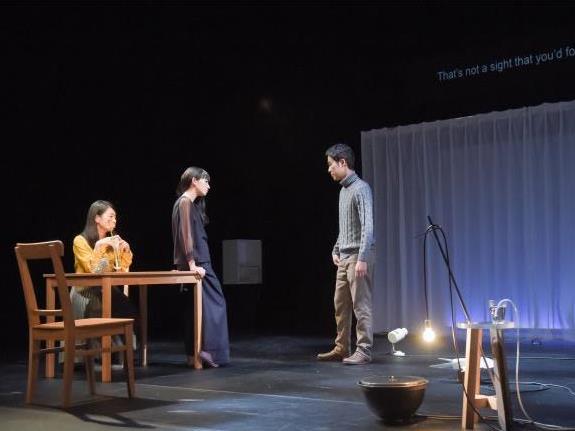Izumi Aoyagi, Mari Ando and Yo Yoshida perform in Time’s Journey Through a Room. Image by Masumi Kawamura
chelfitsch, the contemporary Japanese theatre company behind Time’s Journey Through a Room, derive their name from a deliberate mispronunciation of the word “selfish”. Led by writer and director Toshiki Okada, the company began in 1997, with a commitment to exploring colloquial language and youth culture. Their quiet aesthetic, at once naturalistic and deeply symbolic, has inspired contemporary theatre makers around the world. Locally, there are strong links between chelfitsch and Melbourne company Ranters.
It’s difficult to pin down the style of Time’s Journey Through a Room. The characters sometimes make very formal pronouncements to one another, and their small movements are clearly choreographed amplifications of everyday gestures; and yet, there is a deep sense of naturalism. Complementing this, the stage is littered with obliquely symbolic objects, all of which are illuminated in various ways; none of which is ever referred to explicitly.
There is incredible restraint and discipline in all aspects of this piece. The physicality of the performers suggests naturalistic gesture, but these gestures are exaggerated, or repeated, or carried on for much longer than is natural. And in the text, the characters seem to tell each other exactly how they feel in any given moment, and yet there is much we don’t know about their interior worlds or their circumstances.
Time is immensely flexible here, too. Fans rotate, lights pulse, and naturalistic sounds move rhythmically just beneath the surface of our attention – all of these seem to mark some sort of time. The characters refer to events years in the past and years in the future, and yet we know that we are watching these characters in real time. “Real time” is an interesting concept in this context, as some moments seem to linger for an eternity, whilst other actions seem to spring from nowhere. At all times, there is a sense that each of these characters is trapped in their own bubble of time, and that all they want is to break those bubbles and reach each other in their shared present. When two of the characters manage this, the effect is immensely moving.
This work sets out to explore the internal worlds of those affected by the 2011 earthquakes in Japan. In this context, the meditations on the passage of time, and the contrast between emotions spoken and felt, develop a deeper resonance. But nor is this a work that is deeply tied to its context – in any situation of grief or devastation, for one person or for a whole city (or both), this work has plenty to offer.
The slow, quiet aesthetic of chelfitsch will not be for everyone, and even the most focused of audience members may find their attention wandering from time to time. But here is the genius of this production – in its form, it brings to us the experience of these characters; the effort of trying to connect to the present, and to connect to other people through the present, when there is so much in our pasts and futures that screams for our attention. In such a cluttered and loud world, it’s easy to see why this company – and this work in particular – stands out and softly commands our focus into the quieter, deeper parts of our experience.
Rating: 4 stars out of 5
Time’s Journey Through a Room
Written and directed by Toshiki Okada
Sound and Set Design by Tsuyoshi Hisakado
Performed by Izumi Aoyagi, Mari Ando, Yo Yoshida
Stage Director Koro Suzuki
Sound Director Norimasa Ushikawa
Lighting Director Tomomi Ohira (ASG)
Costume by Kyoko Fujitani (FAIFAI)
English Translation by Aya Ogawa
Assistant Director Yuto Yanagi
Production by chelfitsch
Arts House, North Melbourne Town Hall
Co-presented with Arts Centre Melbourne as part of Asia Topa festival
9-11 February 2017





